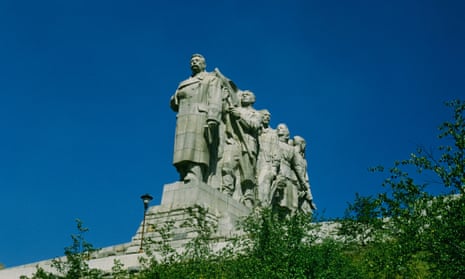The colossal monument to Joseph Stalin that towered over Prague at the height of the cold war stood as a frightening reminder of the Soviet dictator’s tyranny and communism’s seemingly unshakeable grip on the former Czechoslovakia.
Nearly 60 years after its demolition, the brooding 15.5-metre (51ft) shrine retains a hold on the popular imagination, with locals referring to the now popular meeting point where it once stood as “Stalin’s”.
Now archaeologists have unearthed a haunting new finding close to the site of the infamous statue – the remains of a former forced-labour camp used to house workers press-ganged into building it.
The gargantuan structure was commissioned after the communists seized power in Czechoslovakia in 1948 and unleashed a wave of Stalinist terror and show trials. The existence of the camp in Prague’s popular Letná park was previously unknown and had escaped the notice of Czech historians and official bodies dedicated to chronicling the Czech Republic’s 20th-century experience with totalitarianism.
All traces of the encampment were comprehensively erased before the official unveiling of the statue – consisting of 14,200 tonnes of granite and officially titled “a monument to love and friendship” – on a strategic hilltop overlooking Prague’s medieval city centre on May Day, 1955, two years after Stalin’s death.
But its foundations have been exposed by a team from the Czech Academy of Sciences in excavations ordered in advance of the construction of an artificial lake on the site by Prague city council. It is the first time archaeologists have uncovered an installation in Prague built by the communist regime, which fell from power in the 1989 Velvet Revolution – although a similar camp was excavated last year in rural Bohemia, close to the site of a former uranium mine also served by forced labour.
Jan Hasil, of the academy’s Institute of Archaeology, discovered the original plans for the Prague facility – along with contemporary aerial photos confirming its existence – in the archives of the local municipal district during preparations for the excavation.

“It’s typical of camps built by the communist or Nazi regimes that if a demolition was carried out, it was done thoroughly,” said Hasil, who is now calling for a memorial plaque on the spot. “They wanted to leave no evidence, just as every common criminal will hide their own traces.”
However, the stark reality is revealed in the planning documents, which set out provision for three wooden barracks with a capacity of 40 inmates each, housed eight to a room, with simple kitchen facilities. Conditions inside the huts were spartan, with no heating in the bathrooms.
Although the plans specified concrete floors, the excavation has found no evidence of this, suggesting the flooring may have been made of soil. Wine or beer bottles have been among the items dug up in the network of narrow trenches, indicating that inmates were allowed to consume alcohol. Tar marks in the soil have been left by the insulation in the huts’ walls.
The layout reveals a central square, common to concentration camps of the period, for holding daily roll calls, in a process historians say was often used to intimidate and humiliate inmates. “You can compare it to a prisoner of war camp in Nazi time and, so far as I know, the conditions would have been more or less the same as those of the western countries’ prisoners the Nazis held,” said Hasil, calling the discovery “typical of the time of the great crises of the 20th century in central Europe”.
“People in this camp were living in bad conditions,” he added.

The inhabitants are believed to have been soldiers and workers deemed “politically unreliable” by the communist authorities, who typically assigned political opponents – often academics and intellectuals – to manual labour after denying them work in their chosen fields. It is not known if any former inmates are still alive, although Hasil says he has obtained contact details of some relatives.
While the labourers are believed to have been paid and may even have been allowed to leave the camp on occasional visits, they had little choice but to serve on the units, known as auxiliary technical battalions.
“There are known crimes of the communist regime, executions and so on, but this represents another type of crime which is more problematic morally because the regime was misusing the time and lives of the people who were forced to work here,” said Hasil. “Those people could have been studying, working in satisfying jobs or having a family but instead they were forced to be here to construct a monster hovering over Prague.”
Vít Fojtek, head of exhibitions and collections at the Museum of 20th Memory in Prague, said the “hypothesis” that the site had been a forced labour camp was credible but cautioned that definitive historical proof was lacking. “Possible testimonies of witnesses could help,” he added.
But he said such camps were commonplace in the early 1950s, allowing the regime to use ideologically suspect citizens to build major public construction projects. “Virtually anyone could be sent here.The real goal was to tear these people, dangerous to the communist regime, from social ties to their surroundings and isolate them. The idea of the camps was to re-educate people - both through the work itself and through political training.”
The statue’s sculptor, Otakar Švec, horrified by his own creation, killed himself days before it was officially unveiled. The monument quickly became a liability after Nikita Khrushchev, Stalin’s successor as Soviet leader, denounced his predecessor’s crimes. It was eventually blown up in 1962 under pressure from Moscow. The remains are stored in a chamber underneath where the plinth stood.
